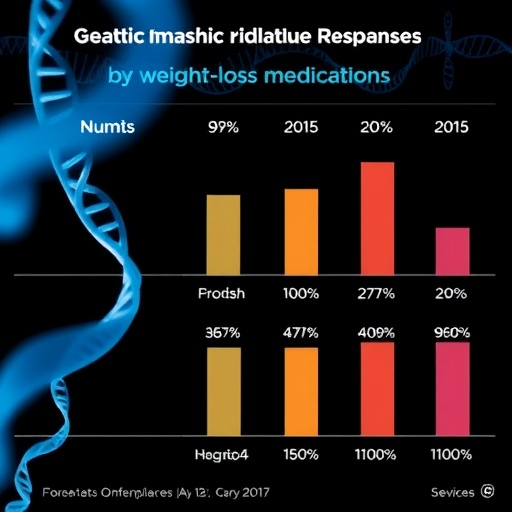ROCHESTER, Minn. — In a groundbreaking advancement poised to transform obesity treatment, researchers at the Mayo Clinic have unveiled a novel genetic test designed to predict individual responses to weight loss medications, particularly those belonging to the glucagon-like peptide-1 (GLP-1) class. This pioneering approach circumvents traditional reliance on superficial body metrics such as body mass index (BMI) and instead probes the intricate biological mechanisms governing appetite and satiation, promising a future where obesity management is custom-tailored to each patient’s physiological makeup.
At the core of this innovation lies the estimation of an individual’s calories to satiation (CTS), a nuanced metric that quantifies how much food is necessary for someone to reach a state of fullness. Researchers have connected CTS to treatment efficacy, observing that the varying thresholds for satiation among individuals can predict how well they might respond to specific pharmacotherapies. By employing sophisticated genetic analysis combined with machine learning algorithms, the team created a composite score known as the Calories to Satiation Genetic Risk Score (CTS-GRS), which delivers a personalized prediction based on genetic variants linked to eating behavior.
Dr. Andres Acosta, a gastroenterologist and the senior author of the study, emphasizes the evolutionary shift this test represents in clinical treatment paradigms. He posits that obesity, a multifaceted and chronic disease affecting over 650 million adults worldwide, cannot be tackled effectively through “one-size-fits-all” prescriptions. Traditional approaches have largely overlooked the biological diversity that underlies obesity, often focusing simply on the outward measurement of body mass instead of the complex interplay of genetics, hormones, and behavior that drives energy intake and expenditure.
The Mayo Clinic team’s research delves deep into the physiology of satiation—the internal signal that signifies when enough food has been consumed. In earlier work, Dr. Acosta and his colleagues identified distinct obesity phenotypes that encapsulate unique eating patterns; for example, the “hungry brain” phenotype, characterized by excessive consumption of large meals, contrasting with the “hungry gut” phenotype, marked by frequent snacking despite average meal sizes. These phenotypes underscore the heterogeneity of obesity and the need for personalized interventions.
In a pivotal clinical study involving nearly 800 adults with obesity, participants were invited to consume an all-you-can-eat meal consisting of lasagna, pudding, and milk until they reached what was described as “Thanksgiving full” — an integrative benchmark of satiation encompassing both physical and sensory fullness. The data unveiled a remarkable range in caloric intake before satiation was achieved, spanning from as low as 140 calories to in excess of 2,000 calories. Importantly, while men on average consumed more than women, conventional factors such as body composition, age, and appetite-related hormones like ghrelin and leptin only modestly explained this vast variability.
Turning to genomics for answers, the researchers analyzed variants in ten key genes known to impact food intake regulation. By synthesizing these genetic elements through machine learning, they derived the CTS-GRS, a robust predictive tool that distills complex genomic information into actionable clinical insights. This transformative score is accessible through a simple blood or saliva test, marking a noninvasive path toward precision medicine.
The applicability of the CTS-GRS was tested in clinical trial cohorts receiving two FDA-approved weight management drugs with distinct mechanisms of action: phentermine-topiramate (Qsymia), a first-generation appetite suppressant, and liraglutide (Saxenda), a GLP-1 receptor agonist that induces satiety through gut-brain axis modulation. Results revealed a compelling stratification: individuals with a high satiation threshold—those requiring more calories before feeling full—benefitted more from phentermine-topiramate, which primarily reduces portion sizes and curbs large meal overeating associated with a “hungry brain.” Conversely, those with low satiation thresholds responded better to liraglutide, which diminishes overall hunger and decreases frequency of eating events typical of the “hungry gut” phenotype.
This genetic insight not only advances personalized pharmacotherapy but also carries significant implications for healthcare economics. Dr. Acosta remarks that applying the CTS-GRS in clinical practice enables clinicians to allocate medications more cost-effectively and improve patient outcomes by aligning treatment choice with biological predispositions rather than trial-and-error approaches. Such precision could reduce the burden of side effects, minimize wasted expenditures, and expedite weight loss success.
Building on these promising findings, ongoing research is examining the predictive utility of the CTS-GRS for response to semaglutide, a newer GLP-1 agonist marketed under brand names such as Ozempic and Wegovy. Additionally, efforts are underway to enhance the test’s predictive capacity by integrating data from the microbiome and metabolome, as well as to develop models that anticipate common adverse effects, including nausea and vomiting, that often limit medication adherence.
Importantly, the CTS-GRS technology has transcended academic settings; it has been licensed to Phenomix Sciences, a Mayo Clinic innovation commercialization partner, and is presently implemented in over 300 clinics across the United States. This broad dissemination attests to the test’s feasibility and clinical value, heralding a new era in obesity medicine where genetic profiling guides targeted therapy.
Such advancements address the long-standing challenge of obesity’s heterogeneity and the inadequacy of BMI as a solitary metric to guide treatment. By harnessing genetic data and marrying it with physiological endpoints like satiation, Mayo Clinic’s research offers the medical community a powerful tool to decode the complex biological underpinnings of eating behavior and customize interventions accordingly.
It is anticipated that as integration with microbiomic and metabolomic analyses matures, and broader datasets feed into increasingly sophisticated computational models, this approach will evolve into a comprehensive platform for predicting drug efficacy and tolerability in obesity management. This move towards systems biology-informed precision medicine is likely to reshape therapeutic landscapes beyond obesity, illustrating the vast potential of merging genetics with clinical pharmacology.
In summary, Mayo Clinic’s CTS-GRS test exemplifies the future of personalized medical care—using genetic and physiological insights to demystify individual variability in satiation and tailor obesity treatments with unprecedented accuracy. As obesity prevalence continues to rise globally, such innovations carry profound promise in enhancing patient care, optimizing resource allocation, and ultimately improving public health outcomes.
Subject of Research: Genetic and physiological predictors of satiation variability and responses to obesity treatment
Article Title: Genetic and physiological insights into satiation variability predict responses to obesity treatment
News Publication Date: 5-Aug-2025
Web References:
https://www.cell.com/cell-metabolism/fulltext/S1550-4131(25)00264-5
Keywords: Weight loss, Genetic testing, Personalized medicine
Tags: advancements in pharmacogenomicsassessing treatment efficacy through geneticsCalories to Satiation Genetic Risk Scoregenetic testing for weight loss drugsimpact of genetics on appetite controlindividualized weight management solutionsinnovative approaches to appetite regulationmachine learning in healthcareMayo Clinic obesity researchobesity management tailored to physiologypersonalized obesity treatment strategiespredicting responses to GLP-1 medications





